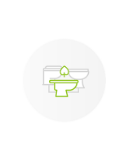Sun-Mar™ Troubleshooting Guide
Where to start...
There are 4 key considerations when addressing faults with the composting system that need to be inspected. Most composting systems have the following design aspects that are key.
Ventilation systems are used to provide the following
- Odour free operation
- Oxygen supply to the composting process
- Drying or evaporating liquids, keeping in mind that for composting to take place the compost itself must have no less than 45% moisture
- Prevent insects from entering the composting system by providing directional air flow
- Is a code requirement
Moisture management systems (leachate drain)
- Leachate in most system is the residual moisture left over from the biological composting process that needs to be discharged
- Leachate drains are generally required to prevent the build-up of moisture in the base of the composting chambers
- Manage moisture when systems are subject to overuse
- Is a code requirement
Organic carbon materials
- Compost would not be compost without the compositions of nitrogen and carbon
- Carbon materials feed the composting process
- Provide a bulking bed for waste (human dejecta) to break down in
- Is a wicking bed for moisture to spread evenly
- Will allow the dejecta to fully break down resulting in rich organic soil in a timely fashion
Human dejecta (waste-not)
- Human dejecta being poos (faecal matter) and wees (urine) is necessary to feed the composting process
- Poos provide to the composting process the base stock for biological life, not only giving nitrogens but introducing bacteria to the process
- Wees provides more nitrogens and maintain the moisture in proportion to the amounts of poos and carbon materials added, preventing the composting from becoming too dry
There are a few more considerations to the effectiveness of composting and these are whether or not you have a heated system and the climatic conditions the system is used in. These are addressed in the manuals and troubleshooting below.
Brief Troubleshooting FAQ’s covered here.
See system manuals for comprehensive Troubleshooting guides (Link)
Why is the compost chamber filling up too quickly?
This can be caused by ineffective composting process due to a number of issues listed below:
Compost pile being too wet
This means the liquid is trapped in the compost chamber contributing to quick volume build up.
Check if the drainage outlet is being blocked - this could be caused by solids blocking the drainage system. See respective manuals for how to clean drain systems.
If drainage outlet is ok, consider the following.
Insufficient air flow
Without sufficient air flow, the evaporation process will be slowed and odours start to escape into the toilet room. A malfunctioning fan or ventilation system can cause this.
Has the ventilation system been blocked by dust, insects, bulking materials or toilet paper?
The fan might not be running, check the electrical connections.
Climate – Temperature & atmosphere conditions
WCTNZ® make every attempt to match you with the right system meeting your site and climate conditions, but there can be changes in weather patterns that lead to less than ideal situations.
In the colder climate, systems can slow down in their rate of processing. Depending on the type of system you have this may not be a problem.
In wetter or salt-laden air climates the system may retain too much moisture as the salt works as a wetting agent by holding on to moisture like water crystals.
Overuse
Although most composting systems have an allowed over-use capacity for guest, there can be unexpected additional users that push the system beyond its limits.
Why is the composting process slow to complete?
Composting process is dependent on temperature and humidity. Listed below are factors that could slow down the process:
Compost pile being too wet
The addition of wood shavings is an imperative part of the operation of a composting toilet. Wood shavings will assist with the absorption of liquid in your composting toilet and will aid in improving the carbon/nitrogen ratio (important for composting) and will allow air to move more freely through the system as it loosens the compost pile.
Compost pile surrounding temperature is too low
You can..
Turn up the heating if your system is a heated model.
Turn down the fan voltage to lessen cool air being drawn into the system. If odour occurs due to the fan voltage being turned down low, simply turn it up slightly to increase airflow.
Add insulation to the tank but not if it’s in a sunny location where the heat is warming the tank.
For the two-stage system where secondary treatment is required, when taking the compost chamber out for secondary composting, make sure it is located in a warm spot preferably in direct sunlight.
How to deal with insects attracted to the compost pile?
Usually, insects in the compost pile indicate that the Humus is too dry. Add a cup of water to the compost.
Insect Control
To break the breeding cycle of insects (most commonly vinegar flies) spray the compost pile with pyrethrum-based insect spray for 7 consecutive days. Always place a layer of wood shavings over the top of the pile in the out of service chamber to eliminate the possibility of insects laying eggs.
Sun-Mar™ - Troubleshooting
The following Guide is available in full from in the official Sun-Mar™ Owner’s Manual.
For your convenience, it is available here in detail if your manual is no longer available. To down load your system manual please login to see your system and corresponding documents.
Odour present in the toilet room
A properly functioning Sun-Mar™ system does not produce odours in the toilet room. Occasionally, however, the draft of the system may become impaired or a leak may develop in a chute or a vent resulting in odour.
Note: You should never use a room exhaust fan where a Sun-Mar™ is installed with an AirFlow fixture as the exhaust fan will draw up any odour from the toilet chute (particularly if the toilet seat is not closed). The fan in the toilet vent pipe will be sufficient to draw any lingering odour out of the toilet room.
Recommended Course of action.
Check that unit is still plugged in and is there power to the plug. Can you hear the fan motor running?
Check your Sun-Mar™ is vented correctly and that the vent pipe connection is airtight.
Check that the humus tray is properly in place.
Check that open windows and doors are not ‘sucking’ air out of the toilet room due to outside air. Turbulence. This can overcome the suction of the vent fan.
Check that the compost is not too wet.
An odour is present outside the building but not inside
Some odour from the top of the vent pipe may occur, but it will rarely if ever be detected at ground level.
This is obviously not a desired occurrence.
Recommended Course of action.
Ensure that the vent pipe is installed correctly and that it clears the roof by at least 0.6m.
If the house is in a very windy area you could be getting a swirling effect which is pushing the ventilation gases back down towards the ground. In this case, the only thing that can be done is to extend the vent pipe into clear air flow above the highest point of the roof.
If the vent is in the wind shadow of nearby trees or buildings, then odour may settle back to ground instead of being dispersed. Extend the vent pipe into clear air flow.
Check that all joins in the vent pipe are sealed and are not leaking. Also check for cracks in the vent pipe and seal with silicone sealant and duct tape.
A strong unpleasant odour is a sign the composting process is not operating in balance. This usually indicates the bulking material should be added more frequently or in greater quantities. Check the state of the compost pile and refer below for any corrections.
Optional Sun-Mar™ filter box available; this will filter the ammonia out of the vented air in a downdraft situation. Call WCTNZ® for details.
Odour is associated with the end-product
In a properly functioning system the final composted material should be virtually odourless, much like garden soil. However, if proper ventilation and oxygen are not provided during the composting process the pile may have become anaerobic.
Recommended Course of action.
Check that the vent fan and/or heating is operating properly.
Return the compost material from the drying tray back into the Sun-Mar™ system for reprocessing and make sure the appropriate bulking materials are being used.
Increase the quantity of bulking materials that are regularly added after each use.
Fan is making a lot of noise
Recommended Course of action.
Check fan for obstructions and clean with a light brush if necessary.
Fan may have been damaged in shipping or bearings are beginning to wear.
The fan may be faulty, phone WCTNZ® for a replacement.
Some Liquid Build up/ Lack of Evaporation in removal access area under the composting chamber (base of system)
With periods of very high use, especially when accompanied by low outside temperatures you may get a liquid build up in the base of the system. This is normal but if there is more than just a few centimetres and there is odour present …
Recommended Course of action.
Ensure that sufficient wood shavings and/or other organic bulking material has been added to the system according to the operation and maintenance instructions. If not… Add several cups full and mix the bio drum well.
Ensure that adequate quantities of wood shavings are regularly added to the system.
Check that the liquid drain is clear from obstruction and has been correctly installed so as to slope away from the chamber and the drain field is not too small to receive the leachate.
The system may not have been cleaned in a while and there is mineral salts accumulated in the evaporation chamber over time, reducing evaporation rates. To remove these, fill the evaporation chamber with very hot water and a good concentration of your environmental cleaner then leave overnight.
A significant liquid build up in the evaporative area (base of system) has occurred
Most likely the Drain Line has become blocked.
Recommended Course of action.
Check the drain outlet fittings is not blocked by any solids or plastics.
- If liquid is non-offensive and a clear ‘tea’ colour, drain off excess liquid and dispose according to local requirements. Followed by.. steps 1&2
- If liquid has an offensive odour or is contaminated with solids or scum, this indicates that the compost pile has become anaerobic (no oxygen). This situation is best remedied by adding a haft a bucket of the bulking materials and mixing well then adding good concentration of your environmental cleaner then leaving overnight. Followed by .. steps 1&2
- Check drain line for kinks, blockages or upward bends. Remove and flush if blockages present, un-kink if bent and ensure that the drain pipe is sloping downward. If your drain pipe is in order, proceed to step 2
- Drain all Liquid through the overflow drain by tipping the unit up (make sure overflow is hooked up first)
There is liquid in finishing drawer (Drying Tray)
The drum screen will be clogged. WCTNZ® provides a good bulking agent mixer that should prevent this from happening.
Recommended Course of action.
Rotate EXCEL drum so that the drum screen can be seen from the access point - you will just be able to see the edge of the screen. Scrub drum screen with a soft wire brush Supplied with the system. If you don’t have one note that it will be a brass wired brush. Return the screen to its original position.
Compost tank is getting too full
Recommended Course of action.
Is the pile too dry, too wet or too cold? (Refer below)
Is the unit being overused (particularly in cooler months)?
Is the composting process active? (Refer below)
The composting process does not seem to be working
Recommended Course of action.
It is normal not to notice any composting for the first six week use of the Sun-Mar™ system as it takes time for the compost to build up a good base for bacteria rich conditions.
Check that the suitable bulking agent is being used.
Check that disinfectant or antibacterial cleaners are not being used in the system.
Is the pile too dry, too wet or too cold? (Refer below)
Adding some rich soil found naturally under trees or material from another compost pile will ensure that the correct microorganisms are present to break down the waste. A bacteria pack from WCTNZ® will also stimulate the process.
Composting pile appears too dry
In normal circumstances there will be sufficient moisture entering the toilet to ensure adequate moisture levels. If however, there have been extended periods of little or no use or where outside temperatures have been very high, it may be necessary to periodically spray the pile with water via the inspection door or through the toilet seat.
Recommended Course of action.
If the system has run dry, add 5L of water into the system, wait 2 hours, then mix. If the compost still seems dry, add another 5L of water and then mix.
Note: Pile should be made damp, not sodden. Optimum moisture content is around 50%.
Compost pile appears too wet
Pile should be damp, not sodden. Optimum moisture content is around 50%. Too wet is a sign that insufficient wood shavings are being added to the pile and/or that the toilet has received heavy use and insufficient maintenance.
Recommended Course of action.
Add several cups full of dry bulking material through the inspection door and mix thoroughly.
Increase the quantity of wood shavings added regularly.
Check the vent fan is operating correctly and vent pipe is clear of obstructions.
Check the heating is still working.
There seems to be too much toilet paper visible on the top of the pile
Ensure sufficient bulking agents are being added regularly (per use).
Consider that some people use much more toilet paper than is necessary.
Recommended Course of action.
Simply dampen down if necessary and agitate top 100mm or so of the compost pile to mix with the wood shavings.
Check that the composting system is not too hot and dry, as moisture will break apart the toilet paper. Simply dampen down if necessary and mix well. Consider the type of toilet paper used. Recycled toilet paper breaks down the fastest and hypoallergenic toilet paper has less chemicals that could resist the composting process but in general this is not a problem.
Composting pile may be too cold for composting
If the compost tank has been correctly sized for the usage and climate, this problem will rectify itself within weeks as the climate will vary as weather paterns can bring in cold spells and the excess drain will deal with the leachate temporally. Sun-Mar™ systems will operate successfully in very cold climates if properly sized and maintained.
Recommended Course of action.
If the tank is in a cold location and is becoming full without sufficient composting occurring, the following measures can increase the rate of decomposition:
Insulate the tank from a concrete floor as the heating element is in the base of the system and will lose heat through the floor.
Provide a heat source to the room the system is housed in. If tank is in a cellar, duct warmer air into the cellar.
Heating system is not working
The heating element is a long-life component and is unlikely to be faulty. Consider the following.
First test if your heating element is definitely not working by:
Pulling the finishing draw out and put your hand in the evaporation chamber (NOT in the liquid). If there is no warmth rising from the floor of the unit, your heating system is not working. It is most commonly the thermostat that has failed. If you notice a Lack of evaporation, but there is still warmth in the heating chamber, see “Liquid Build up” for solutions.
Recommended Course of action.
Thermostat Failure - Have your serial number ready and call WCTNZ® for a replacement. (Detailed instructions are included with the replacement part)
Heating Element Failure - If the insulation behind the electric box is moist or discoloured, or heating does not work after the new thermostat has been connected, then the heating element has failed.
Blown fuse - Check fuse located on the electric box to ensure that it is functioning correctly, if the wire in the fuse is charred or broken, replace the fuse. Have your serial number ready and call WCTNZ® for a replacement (detailed instructions are included with the replacement part). Check fuse located on the electric box to ensure that it is functioning correctly, if the wire in the fuse is charred or broken, replace the fuse.
Undesirable insects in the compost tank
If insects have gotten into the compost one should sprinkle either Insect stopper or any other long lasting powder (pyrethrum based) over the compost and also in the compost drying tray.
Refer to section on Compost Toilets and Insects in the Manual.














